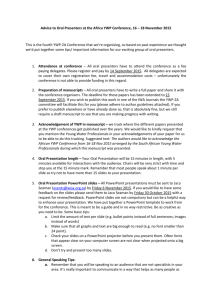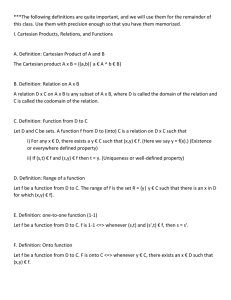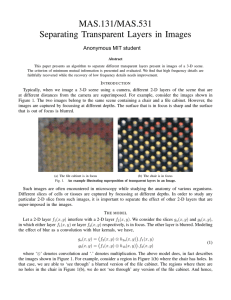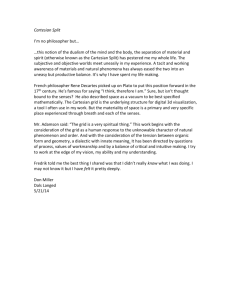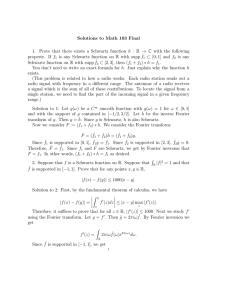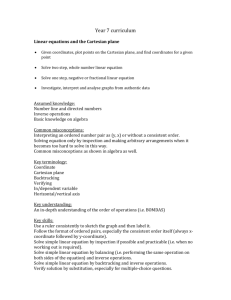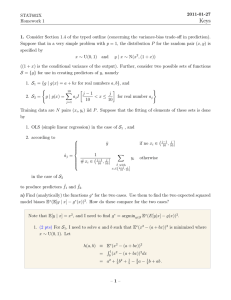ENTIRE CURVES IN COMPLEMENTS OF CARTESIAN PRODUCTS IN C by Nikolai Nikolov
advertisement
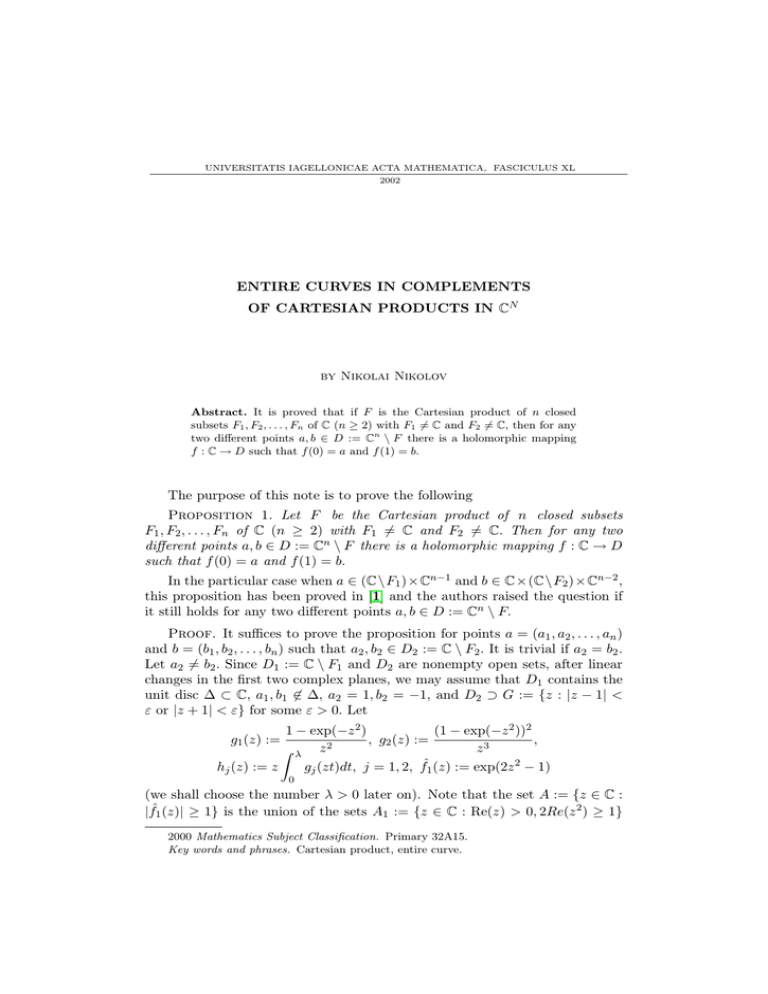
UNIVERSITATIS IAGELLONICAE ACTA MATHEMATICA, FASCICULUS XL
2002
ENTIRE CURVES IN COMPLEMENTS
OF CARTESIAN PRODUCTS IN CN
by Nikolai Nikolov
Abstract. It is proved that if F is the Cartesian product of n closed
subsets F1 , F2 , . . . , Fn of C (n ≥ 2) with F1 6= C and F2 6= C, then for any
two different points a, b ∈ D := Cn \ F there is a holomorphic mapping
f : C → D such that f (0) = a and f (1) = b.
The purpose of this note is to prove the following
Proposition 1. Let F be the Cartesian product of n closed subsets
F1 , F2 , . . . , Fn of C (n ≥ 2) with F1 6= C and F2 6= C. Then for any two
different points a, b ∈ D := Cn \ F there is a holomorphic mapping f : C → D
such that f (0) = a and f (1) = b.
In the particular case when a ∈ (C\F1 )×Cn−1 and b ∈ C×(C\F2 )×Cn−2 ,
this proposition has been proved in [1] and the authors raised the question if
it still holds for any two different points a, b ∈ D := Cn \ F.
Proof. It suffices to prove the proposition for points a = (a1 , a2 , . . . , an )
and b = (b1 , b2 , . . . , bn ) such that a2 , b2 ∈ D2 := C \ F2 . It is trivial if a2 = b2 .
Let a2 6= b2 . Since D1 := C \ F1 and D2 are nonempty open sets, after linear
changes in the first two complex planes, we may assume that D1 contains the
unit disc ∆ ⊂ C, a1 , b1 6∈ ∆, a2 = 1, b2 = −1, and D2 ⊃ G := {z : |z − 1| <
ε or |z + 1| < ε} for some ε > 0. Let
(1 − exp(−z 2 ))2
1 − exp(−z 2 )
,
g
(z)
:=
,
2
z3
Z λ z2
hj (z) := z
gj (zt)dt, j = 1, 2, fˆ1 (z) := exp(2z 2 − 1)
g1 (z) :=
0
(we shall choose the number λ > 0 later on). Note that the set A := {z ∈ C :
|fˆ1 (z)| ≥ 1} is the union of the sets A1 := {z ∈ C : Re(z) > 0, 2Re(z 2 ) ≥ 1}
2000 Mathematics Subject Classification. Primary 32A15.
Key words and phrases. Cartesian product, entire curve.
14
and A2 := {z ∈ C : Re(z) < 0, 2 Re(z 2 ) ≥ 1}. Then there exist numbers
α1 ∈ A1 and α2 ∈ A2 such that fˆ1 (α1 ) = a1 and fˆ1 (α2 ) = b1 . Let z ∈ A1 .
Since g1 (u) and g2 (u) are entire functions, we have
Z λz
Z
|z − 1| 1
dt
|h1 (z) − h1 (1)| = |
g1 (u)du| < 2
λ
|1
+
(z
− 1)t|2
λ
0
(1)
√
Z
dt
|z − 1| 1
2|z − 1|
2 2
≤2
=
<
,
2
λ
λ Re(z)
λ
0 (1 + Re(z − 1)t)
Z λz
Z
and
|z − 1| 1
dt
|h2 (z) − h2 (1)| = |
g2 (u)du| < 4
2
λ
|1
+
(z
− 1)t|3
λ
0
(2)
Z 1
|z − 1|
dt
|z − 1| Re(z + 1)
4
≤4
=2
< 2.
2
3
2
λ
(λ Re(z))
λ
0 (1 + Re(z − 1)t)
Analogously, if z ∈ A2 , then
√
4
2 2
and |h2 (z) − h2 (−1)| < 2 .
(3)
|h1 (z) − h1 (−1)| <
λ
λ
Z ∞
Note that
g1 (t)dt > 0
h1 (1) = −h1 (−1) −→ d1 :=
λ→∞
0
Z ∞
and
h2 (1) = h2 (−1) −→ d2 :=
g2 (t)dt > 0.
λ→∞
0
Now, it follows from (1), (2), (3), and the triangle inequality that for any
λ 1, we may find constants c1 and c2 ((c1 , c2 ) tends to the solution of the
system d1 x1 + d2 x2 = 1, −d1 x1 + d2 x2 = −1, when λ → ∞) such that if
fˆ2 = c1 h1 + c2 h2 , then fˆ2 (α1 ) = 1, fˆ2 (α2 ) = −1, |fˆ2 (z) − 1| < ε for z ∈ A1 ,
and |fˆ2 (z) + 1| < ε for z ∈ A2 . Set l(z) = (α2 − α1 )z + α1 , fj (z) = fˆj (l(z))
for j = 1, 2, and fj (z) = (bj − aj )z + aj for 3 ≤ j ≤ n. Then the mapping
f := (f1 , f2 , . . . , fn ) has the required properties.
Acknowledgments. The author would like thank M. Jarnicki for the
useful remarks on an earlier version of this note.
References
1. Jarnicki W., Nikolov N., Concave domains with trivial biholomorphic invariants, Ann. Pol.
Math., LXXIX (2002), 63–66.
Received
April 15, 2002
Bulgarian Academy of Sciences
Institute of Mathematics and Informatics
1113 Sofia, Bulgaria
e-mail : nik@math.bas.bg
